

1 - THE GENERATOR TRIANGLES
Abstract
The Bible speaks particularly of ultimate origins in Genesis, chapters 1 and 2 (originally recorded in Hebrew), and again in John, chapter 1 (originally recorded in Greek). These are epitomised in two brief statements which typically appear in English translation as "In the beginning God created the heaven(s) and the earth." (Gen.1:1), and "In the beginning was the Word, and the Word was with God, and the Word was God." (John 1:1). Clearly, the second (together with its following verses) extends our understanding of the first in revealing that the Creator is none other than our Lord and Saviour, Jesus Christ! Closely integrated with these verses, and with this Name, are three sets of numbers - representing fair alternative readings of the Hebrew and Greek words. Within these sets we find several instances of an important class of triangular numbers. These reveal the words they underpin to be linked independently of the text and thus provide powerful evidence of intricate design based upon principles that spring from the heart of mathematics.
1. Background
Three appendices are provided, as follows:
Appendix 1 - Reading Hebrew and Greek words as numbers
Appendix 2 - An introduction to the triangular numbers
Appendix 3 - An introduction to the Ulam spiral
These are intended to make this page largely self-contained, (a) by serving to explain the origins of the three data sets around which the analysis is centred, (b) by providing a basis for understanding the numerical geometries involved and, (c) by explaining the Ulam spiral and demonstrating its value in the detection of design and the assessment of probabilities.
2. Introduction
The matters we shall be discussing lend themselves naturally to graphical representation. Here then is the arena within which 'the action' takes place:
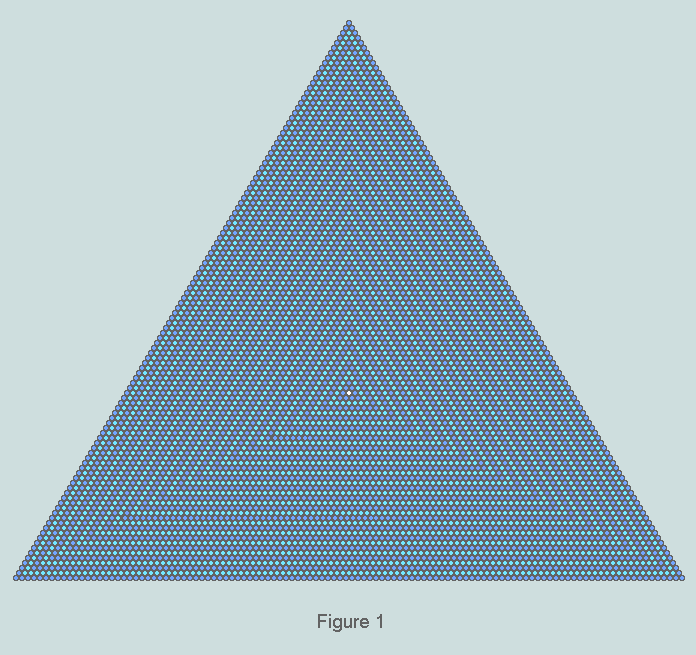
It takes the form of a nested arrangement of the first 37 G-triangles (ie the 'generator triangles' - each so-named because capable of generating a symmetrical hexagon/hexagram pair by self-intersection/-union). The unit representing their common centre is shown in white and, for clarity, their outlines in alternate shades of blue. At the heart of this figure we observe 10 (the first G-triangle proper), 28 (the second) and 55 (the third, and 10th of the general series of triangles). As we shall find, each has a particular significance in the present context. But the main thrust of our thesis is that the numerical representatives of the creation and its Creator are also found clearly depicted here. These are summarised in the following table and detailed in subsequent sections.
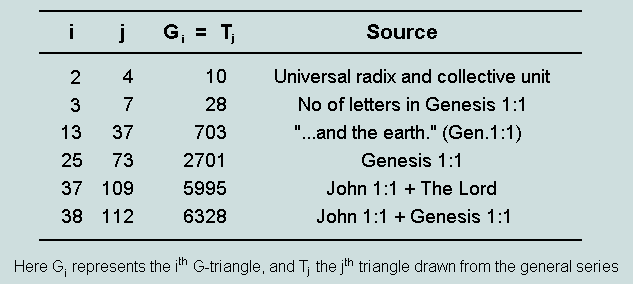
3. The G-triangular implications of Genesis 1:1
The Bible's first verse of 7 Hebrew words is represented numerically by the set of positive integers {913, 203, 86, 401, 395, 407, 296} and their sum 2701 - 25th G-triangle, and 73rd in the general series - having the reflective prime factors 37 and 73. Interestingly, 37/73 form the hexagon/hexagram pair generated by the 3rd G-triangle, 55.
Clearly, "...and the earth." (the English translation of words 6 and 7) constitutes what we might fairly refer to as the "natural" outcome of the divine creativity; we observe the sum of the corresponding numbers to be 703 - 13th G-triangle, and 37th in the general series - having the prime factors 19 and 37. These also constitute a hexagon/hexagram pair - the related G-triangle being the 3rd, 28. This of course happens to be the number of Hebrew letters that convey this fundamental assertion - 28 being the 7th in the general series of triangular numbers and 2nd perfect number (ie it is equal to the sum of its factors - including 1).
The following is a depiction of Genesis 1:1 as 25th G-triangle. A notable feature - referred to in previous pages - is that the outermost ring comprises 216, or 6x6x6, counters.
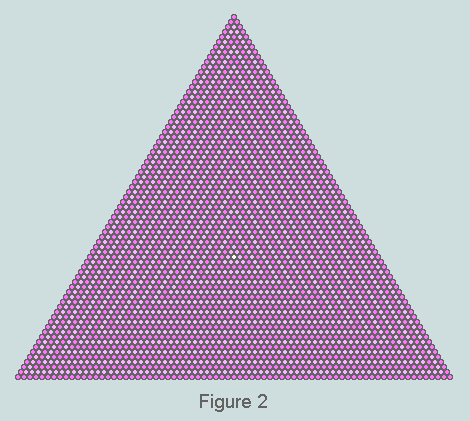
The next shows the 13th G-triangle (representing "...and the earth.") superimposed on the former.
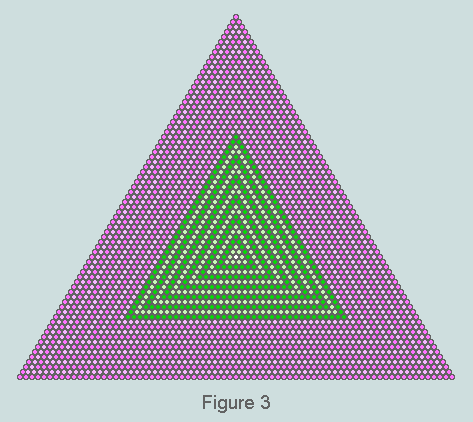
Clearly, the outer structure must now represent 1998 - the sum of the first 5 words of Genesis 1:1. This translates into a triplet of 666-as-triangle following the rotation of the inner triangle through 180 degrees about its centre, thus:
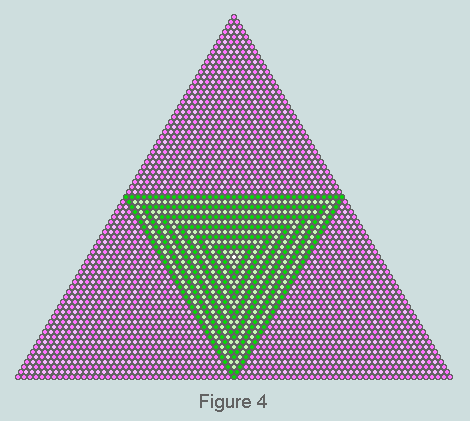
4. Genesis 1:1 as G-triangle plus trapezium
This important division within the verse may be represented somewhat differently, as follows:
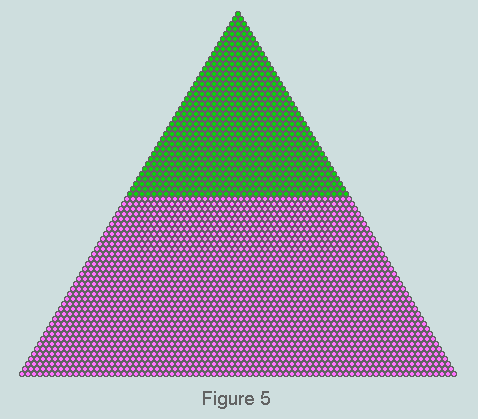
Here the first 5 words appear as a "plinth" supporting the G-triangle representing the "natural" components of the creation. This structure leads us smoothly to a consideration of the liaison between Genesis 1:1 and John 1:1.
5. John 1:1 as plinth to Genesis 1:1
The first verse of John's gospel is represented by the set of 17 positive integers {55, 719, 58, 70, 373, 31, 70, 373, 58, 450, 420, 134, 31, 284, 58, 70, 373} and their sum, 3627 (like 2701, the product of a pair of reflective factors, in this case the composites 39 and 93). Remarkably, when added to 2701 the result is the G-triangle 6328, ie the 38th (and 112th in the general series). It follows that John 1:1 forms a perfect plinth for Genesis 1:1 - as depicted below.
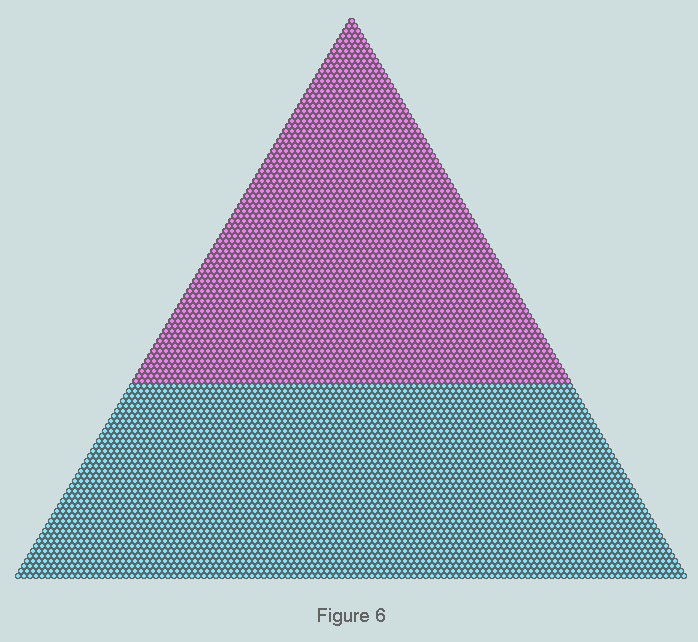
Reverting to the earlier mode of representation, we therefore have the following intriguing composite of biblically-defined G-triangles:
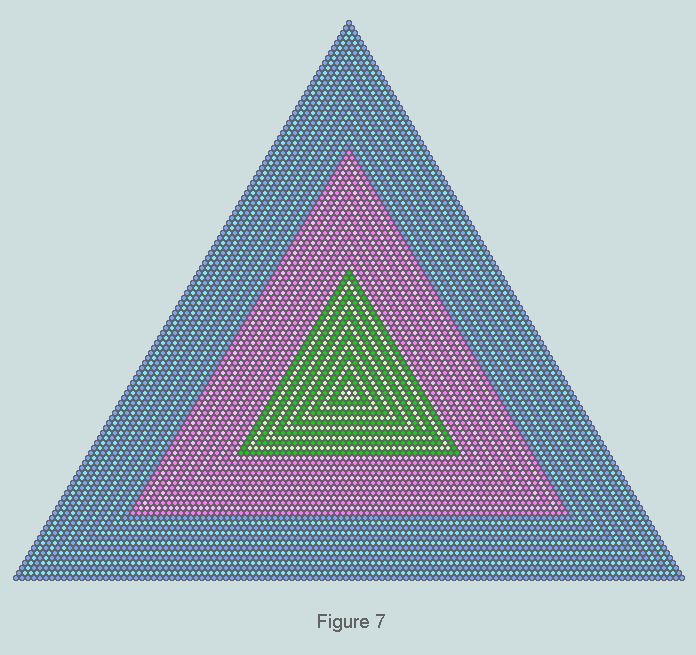
Observe that the "natural components" of the creation (represented by the words "...and the earth") - including ourselves - occupy centre-stage in this structure. Further, at the very heart we see 10, 28 and 55 - numbers having an extra-biblical significance. A further point of interest concerns 333 - the number of counters forming the outermost ring. Remarkably, this fact serves to inscribe these proceedings with the name of our Creator.
6. Jesus Christ - Creator
The first chapter of John's gospel identifies the Creator as the Lord Jesus Christ - the Word of God. It has been shown that the Greek form of the name "Jesus" is represented by 888 in both New Testament and Septuagint (written some 300 years before the Nativity); and the title "Christ" by 1480 - again in both works. It follows that their sum, 2368 - or 64x37 - represents the Creator. This figure is found to be 333 less than 2701 - the numerical representation of Genesis 1:1.
Since the first verses of Genesis and John have been combined to produce the G-triangle of Figure 7, then removing its outermost ring of 333 inevitably leaves the G-triangle representing Creator + John 1:1! Here is that triangle - the 37th of the G-series and 109th of the general series:
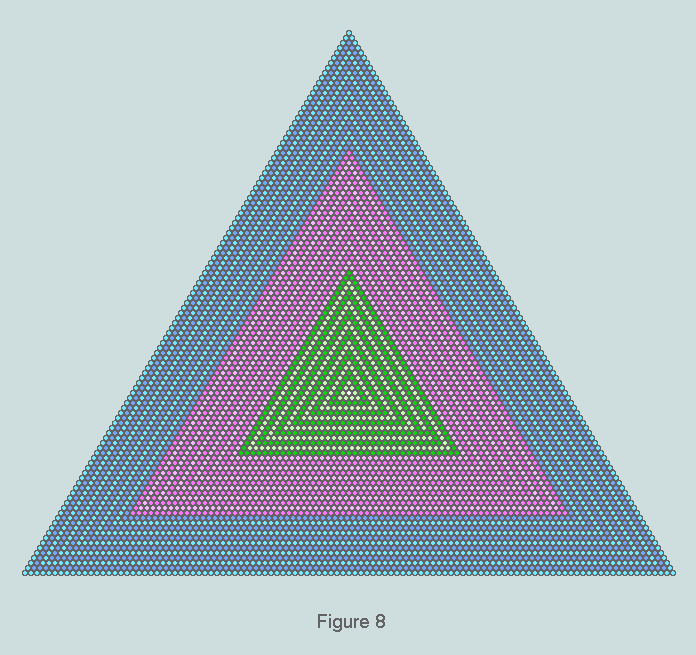
To recap: the complete structure represents Creator + John 1:1, the larger inner triangle Genesis 1:1, and the smaller the final portion of Genesis 1:1, "...and the earth." Observe that two lots of 12 triangular rings of counters separate these figures.
7. Analysis
We may, intuitively, estimate the probability of this remarkable series of events arising by chance by recourse to a Ulam spiral plot of the G-triangles over the range of positive integers 1 - 6,400, as depicted below.
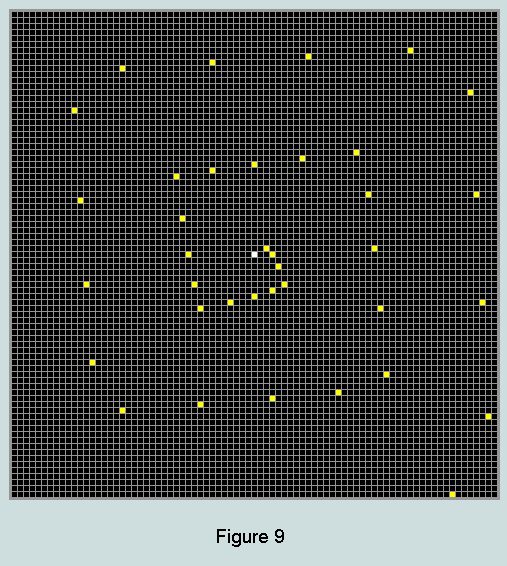
We may now conveniently regard this as a target and consider the chance associated with hitting a yellow square with a random arrow directed at the target. Since there are 37 yellow squares in an area comprising 6,400 this probability is 37/6400, ie 0.00578, or 1 in 173 against. In the foregoing sections it has been demonstrated that five G-triangles are found closely - and independently - associated with the biblical account of Creation. The combined odds are therefore of the order of (1.5 x 10^11) to 1 against.
The following diagram (to be read in association with Figure 9) completes this analysis by providing a key to the location of those G-triangles involved in the foregoing sections. They are here represented by the labelled green squares.
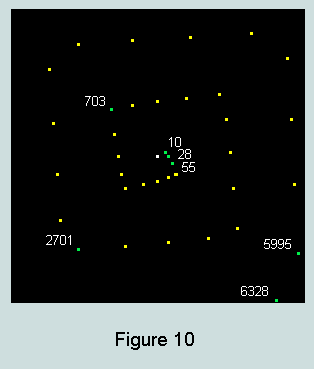
8. Concluding remarks
The foregoing observations strongly suggest that the prime biblical references to the Creation and its Creator have been purposefully aligned with a particular class of numero-geometrical absolutes, viz the G-triangles.
The terms co-equal, consubstantial and co-eternal which are used of the shared features of Father, Son and Holy Spirit - the Triune God of the Christian Scriptures - may be applied with equal relevance to the equilateral triangle as it is found exemplified in the G-triangle. Further, the digits of the numbers represented (expressed in the usual way as a denary or base-10 objects) in every case sum penultimately to 10 - significant anatomical feature of those made in the image of God, and man's preferred choice of collective unit and radix - and, ultimately, to 1. It follows that there can be little doubt concerning the identity of the author of these wonders.
Clearly, this poses formidable questions for both Christian believer and non-believer alike - particularly in respect of Genesis 1:1 whose words preceded the introduction of the Hebrew alphabetic numbering scheme by many centuries. However, it is hard to avoid the conclusion that God has chosen to reveal his being, and a little of his awesome sovereignty, in these phenomena. We read in the Apostle Paul's second epistle to Timothy, "All scripture is given by inspiration of God, and is profitable for doctrine, for reproof, for correction, for instruction in righteousness..." (2Tim.3:16). Let us observe, (a) that the numbers and their accompanying geometries are an integral part of God's Word and therefore form part of 'All scripture' and, (b) that such is the present confusion concerning what is, and what is not, true - particularly among those who count themselves as servants of Christ - that much correction is urgently needed.
The Scriptures make it clear that from time to time God has favoured selected individuals and groups with a demonstration of his supernatural powers - and that, clearly, is his prerogative. Such events were clearly transitory - kept alive only in the memories of those who had witnessed them and, in many cases, undoubtedly to be explained away as strange, but natural, occurrences. Such observations lead one to ask whether miracle can, in any sense, be considered an effective tool for evangelism. The Lord Jesus apparently thought it could (John 10:37,38) - and that should encourage us when we point to the material above as a 'standing miracle' - evidence of which remains available to all who would 'come and see'.
Jesus declared that he alone was the way, the truth, and the life (John 14:6). Dear reader, may the Holy Spirit lead you to believe that fact, for there can be none more important!
Vernon Jenkins MSc
2003-08-15
email: vernon.jenkins@virgin.net